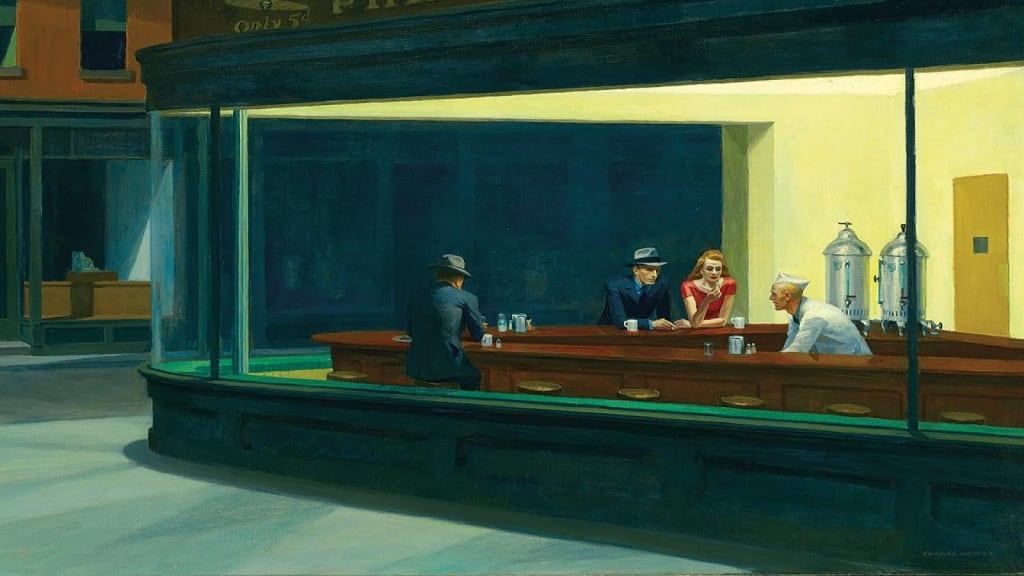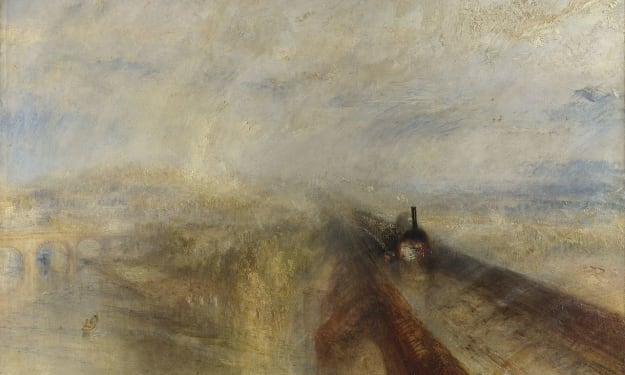Nighthawks, by Edward Hopper
An iconic American painting

Edward Hopper (1882-1967) was a pioneer of the modern realism movement in the United States. During a long career as an artist, Hopper had known both depression and success, and “Nighthawks”, painted in 1942, dates from one of his more productive periods when he was financially secure, in good health, and untroubled in his personal life.
However, it is hard to imagine that “Nighthawks” is the work of a happy and successful man, as the image it conveys is one of isolation and people failing to connect. The reason for this is that success, for Edward Hopper, made little difference to the way he lived or the way he saw his world. The mood of “Nighthawks” is very similar to that of his paintings produced ten or twenty years earlier (or, for that matter, later). It has been pointed out that Hopper began working on “Nighthawks” shortly after the United States was brought into World War II by the Japanese attack on Pearl Harbor, and that this accounted for the general air of gloom in the painting, but that does not explain why Hopper’s earlier work portrayed a very similar mood.
“Nighthawks” is an urban scene, with the viewer being on a deserted street and looking into an all-night “lunch counter”, which is visible through its wrap-around plate glass window. To the left of the painting, on the outside, the street is clean but empty, and the shops across the street have nothing in their windows apart from display stands. On the upper floor there is a row of windows with the blinds half down, illuminated only by the glare of the fluorescent light from the diner.
The viewer’s attention is therefore taken by the scene inside the café. The huge glass windows give the impression of a goldfish bowl through which the viewer can stare. However, there is usually more going on inside a goldfish bowl than there is here.
A counter runs round on two sides. On the side nearer the viewer only one of the seven stools is occupied, by a grey-suited man wearing a hat and with his back to the viewer. On the far side, nearly facing the viewer, a man and a woman sit over their coffees. He looks very similar to the man whose back is turned, whereas the bare-headed woman wears a short-sleeved red dress. Behind the counter a male assistant in a white tunic is at work, although his hands are below the level of the counter so it is not possible to see what he is doing. Against the wall are two coffee urns.
And that is just about everything there is in the painting, which impresses by its starkness. The assistant has his mouth open, as though speaking, but there is no evidence that any of the other characters are listening to him, and he does not seem to be looking at anyone in particular. The couple each have an arm resting on the counter, and their fingers touch, but that is their only communication; the woman is more interested in the fingernails on her other hand, and the man is looking straight ahead of him. There is no animosity in their pose, but no warmth either. To call the man and woman a couple is perhaps misleading; they are two people who happen to be together.
The people are typical of Hopper characters, in that they express hardly anything in terms of emotion, and they are either unable or unwilling to communicate. Hopper’s vision is of individuals who are wrapped up in themselves, and the viewer is forced to ask him or herself whether they are not themselves overly introspective. Hopper denied that he had any social message to convey, but it is hard to escape, given his portrayal of such inanimate people, from the conclusion that each person is essentially on their own.
In “Nighthawks” this impression is reinforced by the sharpness of Hopper’s painting and the harshness of its lighting. Although many of his earlier works had an impressionist feel to them, this is not true here, with the figures being almost photographic in their portrayal. The paint has been applied quite thickly, and the colour palette is limited mainly to reds and browns. The composition relies largely on horizontal and vertical shapes. All of this emphasizes the bleakness of the environment and the vulnerability of the people who seem to be trapped within it.
“Nighthawks” (the title was suggested by Hopper’s wife) has become an iconic image of American urban life and much copied and parodied in other contexts, including comic books and “The Simpsons”. It therefore occupies a similar place in the American consciousness to Grant Wood’s “American Gothic”, although in an urban as opposed to a rural setting.
“Nighthawks” is housed at the Art Institute of Chicago, as is, coincidentally, “American Gothic”.
About the Creator
John Welford
I am a retired librarian, having spent most of my career in academic and industrial libraries.
I write on a number of subjects and also write stories as a member of the "Hinckley Scribblers".






Comments
There are no comments for this story
Be the first to respond and start the conversation.